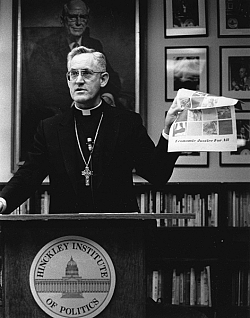The Bishops of Salt Lake City: The Pastor — Bishop William K. Weigand

(Editor’s note: In honor of the 10th anniversary of the Bishop’s Dinner, the Intermountain Catholic is publishing a series of articles featuring the men who have served as Bishop of Salt Lake City.) By Gary Topping Archivist, Diocese of Salt Lake City
All bishops are pastors, but Bishop William K. Weigand’s episcopal motto, "Feed My Lambs," (the first one in English rather than Latin, incidentally) indicated his particular concern with that aspect of his ministry.
Several elements in his background seemed to make him a good fit for our diocese when he was named our bishop in 1980. For one thing, he came from a rural environment much like that of Utah: Born in Bend, Ore., he grew up in the northern Idaho panhandle east of Spokane, Wash. He was ordained for the Diocese of Boise and served his early pastorates there, in its demography of small, widely separated towns with large populations of Mormons and Hispanics. Ministering to those Hispanic Catholics was a particular concern of his bishop, Sylvester Treinan, who insisted that his priests study the Spanish language. Bishop Weigand took to it enthusiastically, attaining an easy fluency in the language and serving almost 10 years as a priest in Cali, Colombia.
Once installed in Salt Lake City, he became immediately concerned that rural Catholics, greatly outnumbered by their Mormon neighbors and isolated from one another, were in particular need of pastoral outreach. Accordingly, before he ever visited the wealthy suburban parishes in the capital city, he journeyed to the farthest corners of the diocese to assure Catholics there that he was aware of them and cared for them. To encourage and support rural pastors, he strengthened the deaneries, the regional administrative structure within which inexperienced and isolated priests could be helped by more senior clergy nearby. In a bold initiative, he sent two Holy Cross Sisters, Patricia Riley and Eileen Dewsnup, to Cedar City, where they took up residency in a mobile home and journeyed far and wide in southwestern Utah to offer catechism classes and other services to meet any local needs, becoming known as the "Gypsy Sisters" for their wandering ways. Finally, he organized regional conferences where rural Catholics would meet the bishop for Mass and a question-and-answer session after a potluck dinner, where they could express their needs and suggestions.
In his travels, and even at the Cathedral of the Madeleine, wherever he encountered Hispanic Catholics, he always included Spanish passages in the liturgy and in his homily. Disdaining residency in the cathedral rectory, he bought a tiny house in a Hispanic neighborhood on Salt Lake City’s west side, where he lived a life of monkish simplicity, growing much of his own food in a backyard garden, and getting around in his beat-up Volkswagen Rabbit.
His most conspicuous contribution to Utah history was his direction of the restoration of the Cathedral of the Madeleine during 1991-93. At a total cost of $10.4 million, it was the most ambitious program ever attempted since the construction of the Cathedral itself, in which the windows were removed, cleaned and reassembled; the interior paint was stripped of almost a century’s accumulation of grime; a new organ installed; the stations of the cross replaced with modern artistic renditions; and the sanctuary area completely redesigned in accordance with the more communal liturgy of Vatican II. Perhaps even more important than the physical changes was the transformation of the Cathedral into, as the slogan went, "A Cathedral for All People," with cultural and artistic programs like the Madeleine Festival of the Arts and Humanities and the Eccles Organ concert series.
Although Bishop Weigand became a proficient fundraiser during the Cathedral project, he recognized, as had Bishop Federal, that the diocese could not ground an effective financial base upon the occasional talented fundraiser and the fortunate donation from a wealthy patron. As Bishop Federal had created the Diocesan Development Drive, Bishop Weigand created the Catholic Foundation of Utah, in which donors could create various endowments for specific purposes or contribute to already existing ones. Today it has grown into an immense financial engine that assures support for diocesan programs into the distant future.
Bishop Weigand’s talents did not go unrecognized. In 1994 he was called to preside over the much larger Diocese of Sacramento. He left behind, in the Diocese of Salt Lake City, a flock of well-fed lambs.
The annual Bishop’s Dinner, which supports the Cathedral of the Madeleine, this year is scheduled for Sept. 26 at The Grand America Hotel, 555 S. Main St., SLC. The guest speaker will be the Most Rev. George H. Niederauer, Archbishop emeritus of San Francisco and the eighth Bishop of Salt Lake City. For information, contact Laurel Dokos-Griffith, 801-328-8941 ext. 108.
© Copyright 2024 The Diocese of Salt Lake City. All rights reserved.

Stay Connected With Us